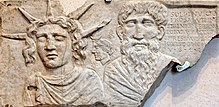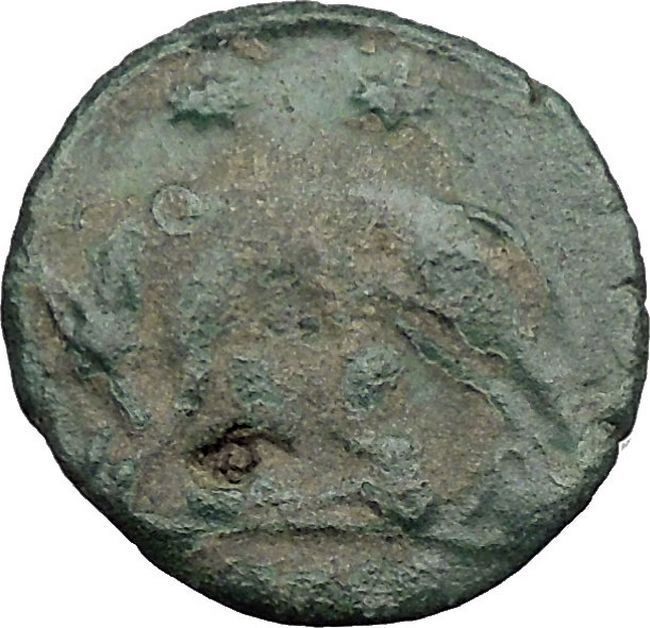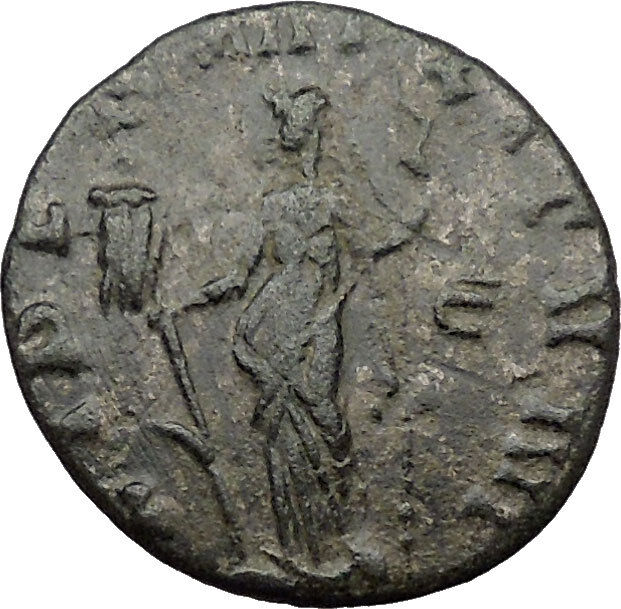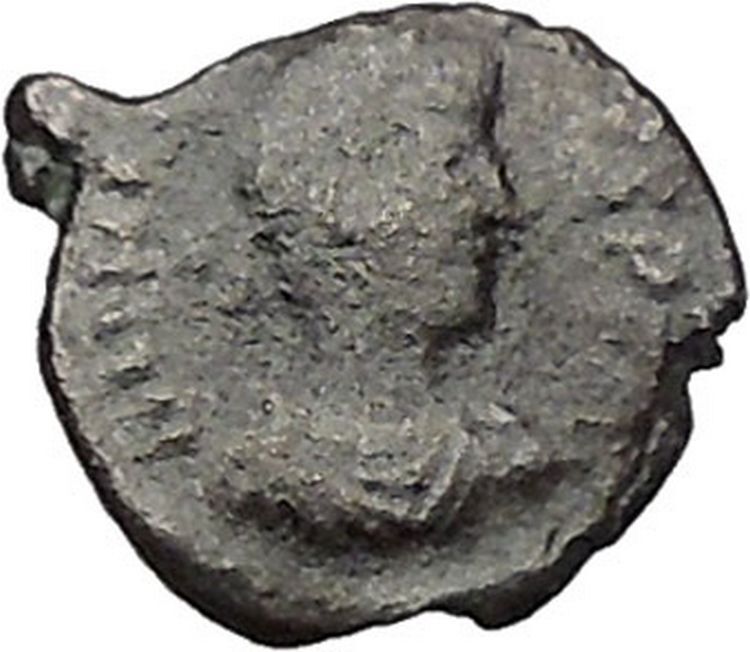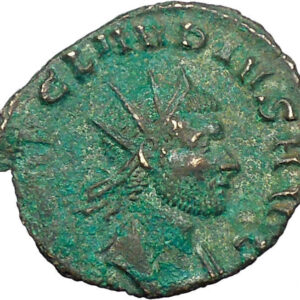|
Gallienus – Roman Emperor: 253-268 A.D. –
Bronze Antoninianus 20mm (3.43 grams) Rome mint 267-268 A.D.
Reference: RIC 160k, C 38
GALLIENVSAVG – Radiate head right.
AETERNITASAVG – Sol standing left, raising hand and holding globe; Γ in left
field.
You are bidding on the exact item pictured,
provided with a Certificate of Authenticity and Lifetime Guarantee of
Authenticity.
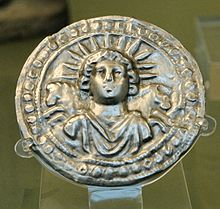
Roman Imperial
repoussé
silver
disc of Sol Invictus (3rd
century), found at
Pessinus
(British
Museum) Sol Invictus (“Unconquered Sun”) was the official
sun god
of the later
Roman Empire
and a patron of soldiers. In 274
the Roman emperor
Aurelian
made it an official
cult alongside the traditional Roman cults. Scholars disagree whether
the new deity was a refoundation of the ancient
Latin
cult of
Sol
,
a revival of the cult of
Elagabalus
or completely new.The god was
favored by emperors after Aurelian and appeared on their coins until
Constantine
.The last inscription referring to
Sol Invictus dates to 387 AD and there were enough devotees in the 5th century
that
Augustine
found it necessary to preach against
them.
It is commonly claimed that the date of 25 December for
Christmas
was selected in order to correspond
with the Roman festival of Dies Natalis Solis Invicti, or “Birthday of
the Unconquered Sun”, but this view is challenged
Invictus as
epithet
Invictus
(“Unconquered, Invincible”) was an
epithet
for
several deities
of
classical Roman religion
, including the supreme
deity
Jupiter
, the war god
Mars
,
Hercules
,
Apollo
and
Silvanus
.[8]
Invictus was in use from the 3rd century BC, and was well-established as
a
cult
title when applied to
Mithras
from the 2nd century onwards. It has a
clear association[vague]
with solar deities and solar monism; as such, it became the preferred epithet of
Rome’s traditional
Sol
and the novel, short-lived Roman state cult
to
Elagabalus
, an
Emesan
solar deity who headed Rome’s official
pantheon under his
namesake emperor
.
The earliest dated use of Sol invictus is in a dedication from Rome,
AD 158. Another, stylistically dated to the 2nd century AD, is inscribed on a
Roman
phalera
: “inventori lucis soli invicto
augusto” (to the contriver of light, sol invictus augustus ). Here
“augustus” is most likely a further epithet of Sol as “august” (an elevated
being, divine or close to divinity), though the association of Sol with the
Imperial house would have been unmistakable and was already established in
iconography and stoic monism. These are the earliest attested examples of Sol as
invictus, but in AD 102 a certain
Anicetus
restored a shrine of Sol; Hijmans
(2009, 486, n. 22) is tempted “to link Anicetus’ predilection for Sol with his
name, the
Latinized
form of the Greek word ἀνίκητος,
which means invictus“.
Elagabalus
The first sun god consistently termed invictus was the
provincial Syrian
god
Elagabalus
. According to the
Historia Augusta
, the
teenaged Severan heir
adopted the name of his
deity and brought his cult image from Emesa to Rome. Once installed as emperor,
he neglected Rome’s traditional State deities and promoted his own as Rome’s
most powerful deity. This ended with his murder in 222.
The Historia Augusta refers to the deity Elagabalus as “also called
Jupiter and Sol” (fuit autem Heliogabali vel Iovis vel Solis).This has
been seen as an abortive attempt to impose the Syrian sun god on Rome;
but because it is now clear that the Roman cult of Sol remained
firmly established in Rome throughout the Roman period,this Syrian
Sol Elagabalus
has become no more relevant to
our understanding of the Roman
Sol
than, for example, the Syrian
Jupiter Dolichenus
is for our understanding of
the Roman Jupiter.
Aurelian
The Roman gens
Aurelian was associated with the cult
of Sol. After his victories in the East, the Emperor
Aurelian
thoroughly reformed the Roman cult of
Sol, elevating the sun-god to one of the premier divinities of the Empire. Where
previously priests of Sol had been simply
sacerdotes
and tended to belong to lower
ranks of Roman society, they were now pontifices and members of the new
college of pontifices
instituted by Aurelian.
Every pontifex of Sol was a member of the senatorial elite, indicating that the
priesthood of Sol was now highly prestigious. Almost all these senators held
other priesthoods as well, however, and some of these other priesthoods take
precedence in the inscriptions in which they are listed, suggesting that they
were considered more prestigious than the priesthood of Sol.Aurelian also built
a new temple for Sol, bringing the total number of temples for the god in Rome
to (at least) four[21]
He also instituted games in honor of the sun god, held every four years from AD
274 onwards.
The identity of Aurelian’s Sol Invictus has long been a subject of scholarly
debate. Based on the
Historia Augusta
, some scholars have argued
that it was based on
Sol Elagablus
(or Elagabla) of
Emesa
. Others, basing their argument on
Zosimus
, suggest that it was based on the
Helios
, the solar god of
Palmyra
on the grounds that Aurelian placed and
consecrated a cult statue of Helios looted from Palmyra in the temple of Sol
Invictus. Professor Gary Forsythe discusses these arguments and add a third more
recent one based on the work of Steven Hijmans. Hijmans argues that Aurelian’s
solar deity was simply the traditional Greco-Roman Sol Invictus.
Constantine
Emperors portrayed Sol Invictus on their official coinage, with a wide range
of legends, only a few of which incorporated the epithet invictus, such
as the legend SOLI INVICTO COMITI, claiming the Unconquered Sun
as a companion to the Emperor, used with particular frequency by Constantine.
Statuettes of Sol Invictus, carried by the standard-bearers,
appear in three places in reliefs on the
Arch of Constantine
. Constantine’s official
coinage continues to bear images of Sol until 325/6. A
solidus
of Constantine as well as a gold
medallion from his reign depict the Emperor’s bust in profile twinned (“jugate”)
with Sol Invictus, with the legend INVICTUS CONSTANTINUS
Constantine decreed (March 7, 321) dies Solis—day of the sun, “Sunday“—as
the Roman day of rest [CJ3.12.2]:
- On the venerable day of the Sun let the magistrates and people residing
in cities rest, and let all workshops be closed. In the country however
persons engaged in agriculture may freely and lawfully continue their
pursuits because it often happens that another day is not suitable for
grain-sowing or vine planting; lest by neglecting the proper moment for such
operations the bounty of heaven should be lost.
Constantine’s triumphal arch was carefully positioned to align with the
colossal statue of Sol
by the
Colosseum
, so that Sol formed the dominant
backdrop when seen from the direction of the main approach towards the arch.[26]
Sol and the
other Roman Emperors
Berrens
deals with coin-evidence of Imperial connection to the Solar
cult. Sol is depicted sporadically on imperial coins in the 1st and 2nd
centuries AD, then more frequently from
Septimius Severus
onwards until AD 325/6.
Sol invictus appears on coin legends from AD 261, well before the reign of
Aurelian.
Connections between the imperial radiate crown and the cult of
Sol are postulated.
Augustus
was posthumously depicted with radiate
crown, as were living emperors from
Nero (after AD 65) to
Constantine
. Some modern scholarship interprets
the imperial radiate crown as a divine, solar association rather than an overt
symbol of Sol; Bergmann calls it a pseudo-object designed to disguise the divine
and solar connotations that would otherwise be politically controversial
but there is broad agreement that coin-images showing the
imperial radiate crown are stylistically distinct from those of the solar crown
of rays; the imperial radiate crown is depicted as a real object rather than as
symbolic light. Hijmans argues that the Imperial radiate crown represents the
honorary wreath awarded to
Augustus
, perhaps posthumously, to commemorate
his victory at the
battle of Actium
; he points out that
henceforth, living emperors were depicted with radiate crowns, but state divi
were not. To Hijmans this implies the radiate crown of living emperors as a link
to Augustus. His successors automatically inherited (or sometimes acquired) the
same offices and honours due to Octavian as “saviour of the Republic” through
his victory at Actium, piously attributed to Apollo-Helios. Wreaths awarded to
victors at the Actian Games were radiate.
Sol
Invictus and Christianity and Judaism

Mosaic of Christ as
Sol
or
Apollo-Helios
in Mausoleum M in the
pre-4th-century necropolis beneath[33]
St. Peter’s in the Vatican
, which
many interpret as representing Christ
The
Philocalian calendar
of AD 354 gives a festival
of “Natalis Invicti” on 25 December. There is limited evidence that this
festival was celebrated before the mid-4th century.
The idea that Christians chose to celebrate the birth of Jesus on 25 December
because this was the date of an already existing festival of the Sol Invictus
was expressed in an annotation to a manuscript of a work by 12th-century Syrian
bishop
Jacob Bar-Salibi
. The scribe who added it
wrote: “It was a custom of the Pagans to celebrate on the same 25 December the
birthday of the Sun, at which they kindled lights in token of festivity. In
these solemnities and revelries the Christians also took part. Accordingly when
the doctors of the Church perceived that the Christians had a leaning to this
festival, they took counsel and resolved that the true Nativity should be
solemnised on that day.”
This idea became popular especially in the 18th and 19th centuries
and is still widely accepted.
In the judgement of the Church of England Liturgical Commission, this view
has been seriously challenged
by a view based on an old tradition, according to which the
date of Christmas was fixed at nine months after 25 March, the date of the
vernal equinox, on which the
Annunciation
was celebrated.
The Jewish calendar date of 14 Nisan was believed to be that
of the beginning of creation, as well as of the Exodus and so of Passover, and
Christians held that the new creation, both the death of Jesus and the beginning
of his human life, occurred on the same date, which some put at 25 March in the
Julian calendar.[40][42][43]
It was a traditional Jewish belief that great men lived a whole number of years,
without fractions, so that Jesus was considered to have been conceived on 25
March, as he died on 25 March, which was calculated to have coincided with 14
Nisan.[44]
Sextus Julius Africanus
(c.160 – c.240) gave 25
March as the day of creation and of the conception of Jesus.
The tractate De solstitia et aequinoctia conceptionis et
nativitatis Domini nostri Iesu Christi et Iohannis Baptistae falsely
attributed to
John Chrysostom
also argued that Jesus was
conceived and crucified on the same day of the year and calculated this as 25
March.
A passage of the Commentary on the prophet Daniel by
Hippolytus of Rome
, written in about 204, has
also been appealed to.
Among those who have put forward this view are Louis Duchesne,Thomas J.
Talley, David J. Rothenberg, J. Neil Alexander, and Hugh Wybrew.
Not all scholars who view the celebration of the birth of Jesus on 25
December as motivated by the choice of the winter solstice rather than
calculated on the basis of the belief that he was conceived and died on 25 March
agree that it constituted a deliberate Christianization of a festival of the
Birthday of the Unconquered Sun. Michael Alan Anderson writes:
Both the sun and Christ were said to be born anew on December 25. But
while the solar associations with the birth of Christ created powerful
metaphors, the surviving evidence does not support such a direct association
with the Roman solar festivals. The earliest documentary evidence for the
feast of Christmas makes no mention of the coincidence with the winter
solstice. Thomas Talley has shown that, although the Emperor Aurelian’s
dedication of a temple to the sun god in the Campus Martius (C.E. 274)
probably took place on the ‘Birthday of the Invincible Sun’ on December 25,
the cult of the sun in pagan Rome ironically did not celebrate the winter
solstice nor any of the other quarter-tense days, as one might expect. The
origins of Christmas, then, may not be expressly rooted in the Roman
festival.
The same point is made by Hijmans: “It is cosmic symbolism…which inspired
the Church leadership in Rome to elect the southern solstice, December 25, as
the birthday of Christ … While they were aware that pagans called this day the
‘birthday’ of Sol Invictus, this did not concern them and it did not play any
role in their choice of date for Christmas.” He also states that, “while the
winter solstice on or around December 25 was well established in the Roman
imperial calendar, there is no evidence that a religious celebration of Sol on
that day antedated the celebration of Christmas”.
The Oxford Companion to Christian Thought also remarks on the
uncertainty about the order of precedence between the celebrations of the
Birthday of the Unconquered Sun and the birthday of Jesus: “This ‘calculations’
hypothesis potentially establishes 25 December as a Christian festival before
Aurelian’s decree, which, when promulgated, might have provided for the
Christian feast both opportunity and challenge.”
Susan K. Roll also calls “most extreme” the unproven hypothesis that “would
call Christmas point-blank a ‘christianization’ of Natalis Solis Invicti, a
direct conscious appropriation of the pre-Christian feast, arbitrarily placed on
the same calendar date, assimilating and adapting some of its cosmic symbolism
and abruptly usurping any lingering habitual loyalty that newly-converted
Christians might feel to the feasts of the state gods”.
The comparison of Christ with the astronomical
Sun
is common in ancient Christian writings.
In the 5th century,
Pope Leo I
(the Great) spoke in several sermons
on the Feast of the Nativity of how the celebration of Christ’s birth coincided
with increase of the sun’s position in the sky. An example is: “But this
Nativity which is to be adored in heaven and on earth is suggested to us by no
day more than this when, with the early light still shedding its rays on nature,
there is borne in upon our senses the brightness of this wondrous mystery.
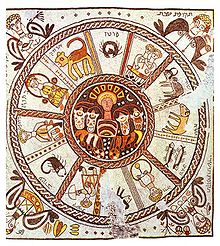
Mosaic in the
Beth Alpha
synagogue, with the sun
in the centre, surrounded by the twelve zodiac constellations and
with the four seasons associated inaccurately with the
constellations
A study of
Augustine of Hippo
remarks that his exhortation
in a Christmas sermon, “Let us celebrate this day as a feast not for the sake of
this sun, which is beheld by believers as much as by ourselves, but for the sake
of him who created the sun”, shows that he was aware of the coincidence of the
celebration of Christmas and the Birthday of the Unconquered Sun, although this
pagan festival was celebrated at only a few places and was originally a
peculiarity of the Roman city calendar. It adds: “He also believes, however,
that there is a reliable tradition which gives 25 December as the actual date of
the birth of our Lord.”
By “the sun of righteousness” in
Malachi 4:2
“the
fathers
, from
Justin
downward, and nearly all the earlier
commentators understand Christ, who is supposed to be described as the
rising sun”.
The
New Testament
itself contains a hymn fragment:
“Awake, O sleeper, and arise from the dead, and Christ will shine on you.”
Clement of Alexandria
wrote of “the Sun of the
Resurrection, he who was born before the dawn, whose beams give light”.
Christians adopted the image of the Sun (Helios
or Sol Invictus) to represent Christ. In this portrayal he is a beardless figure
with a flowing cloak in a chariot drawn by four white horses, as in the mosaic
in Mausoleum M discovered under
Saint Peter’s Basilica
and in an
early-4th-century catacomb fresco.
Clement of Alexandria had spoken of Christ driving his chariot
in this way across the sky. The nimbus of the figure under Saint Peter’s
Basilica is described by some as rayed,
as in traditional pre-Christian representations, but another
has said: “Only the cross-shaped nimbus makes the Christian significance
apparent” (emphasis added). Yet another has interpreted the figure as a
representation of the sun with no explicit religious reference whatever, pagan
or Christian.
The traditional image of the sun is used also in Jewish art. A mosaic floor
in Hamat Tiberias
presents
David
as Helios surrounded by a ring with the
signs of the zodiac
.As well as in Hamat Tiberias, figures of
Helios or Sol Invictus also appear in several of the very few surviving schemes
of decoration surviving from Late Antique
synagogues
, including
Beth Alpha
,
Husefah
(Husefa) and
Naaran
, all now in
Israel
. He is shown in floor mosaics, with the
usual radiate halo, and sometimes in a
quadriga
, in the central roundel of a circular
representation of the zodiac or the seasons. These combinations “may have
represented to an agricultural Jewish community the perpetuation of the annual
cycle of the universe or … the central part of a calendar”.
Gallienus (Latin:
Publius Licinius Egnatius Gallienus Augustus;
c. 218 – 268) was
Roman Emperor
with his father
Valerian
from 253 to 260 and alone from 260 to
268. He ruled during the
Crisis of the Third Century
that nearly caused
the collapse of the empire. While he won a number of military victories, he was
unable to prevent the secession of important provinces.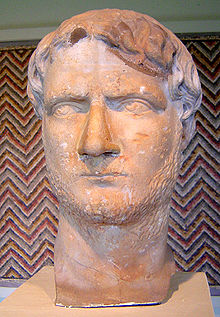
Life
Rise to power
The exact birth date of Gallienus is unknown. The Greek chronicler
John Malalas
and the Epitome de Caesaribus
report that he was about 50 years old at the time of his death, meaning he was
born around 218. He was the son of emperor
Valerian
and
Mariniana
, who may have been of senatorial
rank, possibly the daughter of
Egnatius Victor Marinianus
, and his brother was
Valerianus Minor
. Inscriptions on coins connect
him with Falerii
in
Etruria
, which may have been his birthplace; it
has yielded many inscriptions relating to his mother’s family, the Egnatii.[3]
Gallienus married
Cornelia Salonina
about ten years before his
accession to the throne. She was the mother of three princes:
Valerian II
, who died in 258;
Saloninus
, who was named co-emperor but was
murdered in 260 by the army of general Postumus; and
Marinianus
, who was killed in 268, shortly
after his father was assassinated.
When
Valerian
was proclaimed Emperor on 22 October
253, he asked the
Senate
to ratify the elevation of Gallienus to
Caesar and
Augustus
. He was also designated
Consul Ordinarius
for 254. As
Marcus Aurelius
and his adopted brother
Lucius Verus
had done a century earlier,
Gallienus and his father divided the Empire. Valerian left for the East to stem
the Persian threat, and Gallienus remained in Italy to repel the Germanic tribes
on the Rhine
and
Danube
.
Division of the empire
had become necessary due
to its sheer size and the numerous threats it faced, and it facilitated
negotiations with enemies who demanded to communicate directly with the emperor.
Early
reign and the revolt of Ingenuus
Gallienus spent most of his time in the provinces of the Rhine area (Germania
Inferior,
Germania Superior
,
Raetia
, and
Noricum
), though he almost certainly visited
the Danube
area and
Illyricum
during 253 to 258. According to
Eutropius and Aurelius Victor, he was particularly energetic and successful in
preventing invaders from attacking the German provinces and Gaul, despite the
weakness caused by Valerian’s march on Italy against
Aemilianus
in 253. According to numismatic
evidence, he seems to have won many victories there, and a victory in
Roman Dacia
might also be dated to that period.
Even the hostile Latin tradition attributes success to him at this time.
In 255 or 257, Gallienus was made Consul again, suggesting that he briefly
visited Rome on those occasions, although no record survives. During his Danube
sojourn (Drinkwater suggests in 255 or 256), he proclaimed his elder son
Valerian II
Caesar and thus official heir to
himself and Valerian I; the boy probably joined Gallienus on campaign at that
time, and when Gallienus moved west to the Rhine provinces in 257, he remained
behind on the Danube as the personification of Imperial authority.
Sometime between 258 and 260 (the exact date is unclear), while Valerian was
distracted with the ongoing invasion of Shapur in the East, and Gallienus was
preoccupied with his problems in the West,
Ingenuus
, governor of at least one of the
Pannonian provinces, took advantage and declared himself emperor. Valerian II
had apparently died on the Danube, most likely in 258. Ingenuus may have been
responsible for that calamity. Alternatively, the defeat and capture of Valerian
at the
battle of Edessa
may have been the trigger for
the subsequent revolts of Ingenuus,
Regalianus
, and
Postumus
. In any case, Gallienus reacted with
great speed. He left his son
Saloninus
as Caesar at
Cologne
, under the supervision of Albanus (or
Silvanus) and the military leadership of Postumus. He then hastily crossed the
Balkans
, taking with him the new cavalry corps
(comitatus) under the command of
Aureolus
and defeated Ingenuus at
Mursa
or
Sirmium
.The victory must be attributed mainly
to the cavalry and its brilliant commander. Ingenuus was killed by his own
guards or committed suicide by drowning himself after the fall of his capital,
Sirmium.
Invasion of the
Alamanni
A major invasion by the
Alemanni
and other Germanic tribes occurred
between 258 and 260 (it is hard to fix the precise date of these
events),probably due to the vacuum left by the withdrawal of troops supporting
Gallienus in the campaign against Ingenuus.
Franks
broke through the lower Rhine, invading
Gaul, some reaching as far as southern Spain, sacking Tarraco (modern
Tarragona
).The Alamanni invaded, probably
through
Agri Decumates
(an area between the upper Rhine
and the upper Danube), likely followed by the
Juthungi
. After devastating Germania Superior
and Raetia (parts of southern
France
and
Switzerland
), they entered Italy, the first
invasion of the Italian peninsula, aside from its most remote northern regions,
since Hannibal
500 years before. When invaders
reached the outskirts of Rome, they were repelled by an improvised army
assembled by the Senate, consisting of local troops (probably prǣtorian guards)
and the strongest of the civilian population.On their retreat through northern
Italy, they were intercepted and defeated in the
battle of Mediolanum
(near present day
Milan
) by Gallienus’ army, which had advanced
from Gaul, or from the Balkans after dealing with the Franks.The battle of
Mediolanum was decisive, and the Alamanni didn’t bother the empire for the next
ten years. The Juthungi managed to cross the Alps with their valuables and
captives from Italy. An historian in the 19th century suggested that the
initiative of the Senate gave rise to jealousy and suspicion by Gallienus, thus
contributing to his exclusion of senators from military commands.
The revolt of
Regalianus
Around the same time,
Regalianus
, a military commander of
Illyricum
, was proclaimed Emperor. The reasons
for this are unclear, and the Historia Augusta (almost the sole resource
for these events) does not provide a credible story. It is possible the seizure
can be attributed to the discontent of the civilian and military provincials,
who felt the defense of the province was being neglected.
Regalianus held power for some six months and issued coins bearing his image.
After some success against the
Sarmatians
, his revolt was put down by the
invasion of Roxolani
into
Pannonia
, and Regalianus himself was killed
when the invaders took the city of
Sirmium
. There is a suggestion that Gallienus
invited Roxolani to attack Regalianus, but other historians dismiss the
accusation.It is also suggested that the invasion was finally checked by
Gallienus near Verona
and that he directed the restoration of
the province, probably in person.
Capture of Valerian, revolt of Macrianus
In the East, Valerian was confronted with serious troubles. A band of
Scythians
set a naval raid against
Pontus
, in the northern part of modern Turkey.
After ravaging the province, they moved south into
Cappadocia
. Valerian led troops to intercept
them but failed, perhaps because of a plague that gravely weakened his army, as
well as the contemporary invasion of northern
Mesopotamia
by
Shapur I
, ruler of the
Sassanid Empire
.
In 259 or 260, the Roman army was defeated in the
Battle of Edessa
, and Valerian was taken
prisoner. Shapur’s army raided
Cilicia
and
Cappadocia
(in present day
Turkey
), sacking, as Shapur’s inscriptions
claim, 36 cities. It took a rally by an officer
Callistus
(Balista), a fiscal official named
Fulvius Macrianus
, the remains of the Eastern
Roman legions, and
Odenathus
and his
Palmyrene
horsemen to turn the tide against
Shapur. The Persians were driven back, but Macrianus proclaimed his two sons
Quietus
and
Macrianus
(sometimes misspelled Macrinus) as
emperors. Coins struck for them in major cities of the East indicate
acknowledgement of the usurpation. The two Macriani left Quietus, Ballista, and,
presumably, Odenathus to deal with the Persians while they invaded Europe with
an army of 30,000 men, according to the Historia Augusta. At first they
met no opposition. The Pannonian legions joined the invaders, being resentful of
the absence of Gallienus. He sent his successful commander Aureolus against the
rebels, however, and the decisive battle was fought in the spring or early
summer of 261, most likely in Illyricum, although
Zonaras
locates it in Pannonia. In any case,
the army of the usurpers surrendered, and their two leaders were killed.
In the aftermath of the battle, the rebellion of Postumus had already
started, so Gallienus had no time to deal with the rest of the usurpers, namely
Balista and Quietus. He came to an agreement with Odenathus, who had just
returned from his victorious Persian expedition. Odenathus received the title of
dux Romanorum and besieged the usurpers, who were based at
Emesa
. Eventually, the people of Emesa killed
Quietus, and Odenathus arrested and executed Balista about November 261.
The revolt of Postumus
After the defeat at Edessa, Gallienus lost control over the provinces of
Britain, Spain, parts of Germania, and a large part of Gaul when another
general, Postumus
, declared his own realm (usually known
today as the
Gallic Empire
). The revolt partially coincided
with that of
Macrianus
in the East. Gallienus had installed
his son Saloninus and his guardian,
Silvanus
, in Cologne in 258. Postumus, a
general in command of troops on the banks of the Rhine, defeated some raiders
and took possession of their spoils. Instead of returning it to the original
owners, he preferred to distribute it amongst his soldiers. When news of this
reached Silvanus, he demanded the spoils be sent to him. Postumus made a show of
submission, but his soldiers mutinied and proclaimed him Emperor. Under his
command, they besieged Cologne, and after some weeks the defenders of the city
opened the gates and handed Saloninus and Silvanus to Postumus, who had them
killed. The dating of these events is not accurate, but they apparently occurred
just before the end of 260. Postumus claimed the consulship for himself and one
of his associates, Honoratianus, but according to D.S. Potter, he never tried to
unseat Gallienus or invade Italy.
Upon receiving news of the murder of his son, Gallienus began gathering
forces to face Postumus. The invasion of the Macriani forced him to dispatch
Aureolus with a large force to oppose them, however, leaving him with
insufficient troops to battle Postumus. After some initial defeats, the army of
Aureolus, having defeated the Macriani, rejoined him, and Postumus was expelled.
Aureolus was entrusted with the pursuit and deliberately allowed Postumus to
escape and gather new forces. Gallienus returned in 263 or 265 and surrounded
Postumus in an unnamed Gallic city. During the siege, Gallenus was severely
wounded by an arrow and had to leave the field. The standstill persisted until
the death of Gallienus, and the
Gallic Empire
remained independent until 274.
The revolt of
Aemilianus
In 262, the mint in
Alexandria
started to again issue coins for
Gallienus, demonstrating that Egypt had returned to his control after
suppressing the revolt of the Macriani. In spring of 262, the city was wrenched
by civil unrest as a result of a new revolt. The rebel this time was the prefect
of Egypt,
Lucius Mussius Aemilianus
, who had already
given support to the revolt of the Macriani. The correspondence of bishop
Dionysius of Alexandria
provides a colourful
commentary on the sombre background of invasion, civil war, plague, and famine
that characterized this age.
Knowing he could not afford to lose control of the vital Egyptian granaries,
Gallienus sent his general Theodotus against Aemilianus, probably by a naval
expedition. The decisive battle probably took place near Thebes, and the result
was a clear defeat of Aemilianus. In the aftermath, Gallienus became Consul
three more times in 262, 264, and 266.
Herulian invasions, revolt of Aureolus, conspiracy and death
In the years 267–269, Goths and other barbarians invaded the empire in great
numbers. Sources are extremely confused on the dating of these invasions, the
participants, and their targets. Modern historians are not even able to discern
with certainty whether there were two or more of these invasions or a single
prolonged one. It seems that, at first, a major naval expedition was led by the
Heruli
starting from north of the
Black Sea
and leading in the ravaging of many
cities of Greece (among them,
Athens
and
Sparta
). Then another, even more numerous army
of invaders started a second naval invasion of the empire. The Romans defeated
the barbarians on sea first. Gallienus’ army then won a battle in
Thrace
, and the Emperor pursued the invaders.
According to some historians, he was the leader of the army who won the great
Battle of Naissus
, while the majority believes
that the victory must be attributed to his successor,
Claudius II
.
In 268, at some time before or soon after the battle of Naissus, the
authority of Gallienus was challenged by
Aureolus
, commander of the cavalry stationed in
Mediolanum
(Milan),
who was supposed to keep an eye on
Postumus
. Instead, he acted as deputy to
Postumus until the very last days of his revolt, when he seems to have claimed
the throne for himself. The decisive battle took place at what is now
Pontirolo Nuovo
near Milan; Aureolus was
clearly defeated and driven back to Milan. Gallienus laid siege to the city but
was murdered during the siege. There are differing accounts of the murder, but
the sources agree that most of Gallienus’ officials wanted him dead. According
to the
Historia Augusta
, an unreliable source compiled
long after the events it describes, a conspiracy was led by the commander of the
guard
Aurelius Heraclianus
and Marcianus.
Cecropius, commander of the Dalmatians, spread the word that the forces of
Aureolus were leaving the city, and Gallienus left his tent without his
bodyguard, only to be struck down by Cecropius.One version has Claudius selected
as Emperor by the conspirators, another chosen by Gallienus on his death bed;
the Historia Augusta was concerned to substantiate the descent of the
Constantinian dynasty
from Claudius, and this
may explain its accounts, which do not involve Claudius in the murder. The other
sources (Zosimus
i.40 and
Zonaras
xii.25) report that the conspiracy was
organized by Heraclianus, Claudius, and
Aurelian
.
According to Aurelius Victor and Zonaras, on hearing the news that Gallienus
was dead, the Senate in Rome ordered the execution of his family (including his
brother Valerianus and son Marinianus) and their supporters, just before
receiving a message from Claudius to spare their lives and deify his
predecessor.
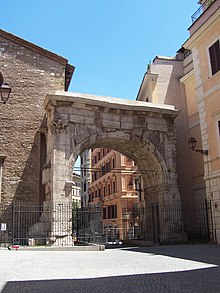
Arch of Gallienus
in Rome, 262 –
dedicated to, rather than built by, Gallienus.
Legacy
Gallienus was not treated favorably by ancient historians, partly due to the
secession of Gaul and
Palmyra
and his inability to win them back.
According to modern scholar Pat Southern, some historians now see him in a more
positive light.Gallienus produced some useful reforms. He contributed to
military history as the first to commission primarily
cavalry
units, the
Comitatenses
, that could be dispatched anywhere
in the Empire in short order. This reform arguably created a precedent for the
future emperors
Diocletian
and
Constantine I
.
The biographer
Aurelius Victor
reports that Gallienus forbade
senators
from becoming military commanders.
This policy undermined senatorial power, as more reliable
equestrian
commanders rose to prominence. In
Southern’s view, these reforms and the decline in senatorial influence not only
helped Aurelian to salvage the Empire, but they also make Gallienus one of the
emperors most responsible for the creation of the
Dominate
, along with
Septimius Severus
, Diocletian, and Constantine
I.
By portraying himself with the attributes of the gods on his coinage,
Gallienus began the final separation of the Emperor from his subjects.A late
bust of Gallienus (see above) depicts him with a largely blank face, gazing
heavenward, as seen on the famous stone head of
Constantine I
. One of the last rulers of Rome
to be theoretically called “Princeps”, or First Citizen, Gallienus’ shrewd
self-promotion assisted in paving the way for those who would be addressed with
the words “Dominus et Deus” (Lord and God).
-
Antoninianus
issued to celebrate
LEG II ITAL VII P VII F, “ItalicaLegio
II seven
times faithful and loyal.”
-
Antoninianus issued to celebrate LEG III ITAL VI P VI F,
“ItalicaLegio
III six times
faithful and loyal.”
-
Antoninianus issued to celebrate LEG VII MAC VI P VI F,
“MacedonicaLegio
VII six
times faithful and loyal.”
-
Antoninianus issued to celebrate LEG VII CLA VI P VI F,
“ClaudiaLegio
VII six
|






